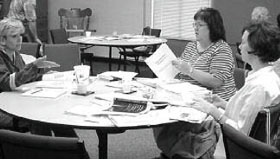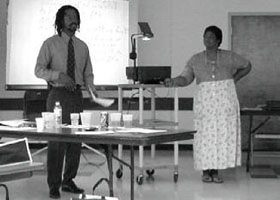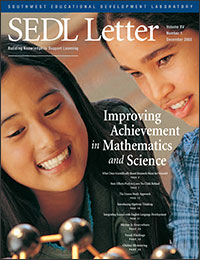The Lesson Study Approach: Collaboration and Creativity Are Key to Teaching Mathematics Concepts
The fifth graders filed into their classroom and arranged their desks in groups of three for their mathematics lesson. The teacher placed two Hershey's™ chocolate bars, each composed of 12 little sections, on the middle person's desk in each group. The students exchanged looks of glee. Were they supposed to eat the chocolate bars? Surely the chocolate had nothing to do with math. But because of the chocolate bars, these students at Howard Perrin Elementary School in Benton, Arkansas, went home that day with a better understanding of proportional reasoning and unitizing.

Oklahoma teachers Dawn Mills, Glenda Pettus, and Lesley Zellinger prepare a lesson plan during the Teachers as Leaders Summer Academy.
They learned that a unit could be more than one thing, such as three pizzas, five pencils, or, in this case, the two candy bars on the paper plates in front of them. The teacher had removed three sections from one of the chocolate bars in each group. "How much candy do you have on that plate?" the teacher asked each of the groups. One group who looked at the candy bars as a whole answered, "1 3/4."Another group, who saw the candy bars as 24 sections said, "21/24" or "7/8." By the time all the groups had finished answering the question, the teacher had written six different numbers on the board. "How can all of these answers be right?" she asked her students. The students realized their answers didn't make sense until they labeled their numbers with units.
The Logic Behind the Lesson Study Model
Unitizing, or the cognitive assignment of a unit of measurement to a given quantity, is a component of proportional reasoning. To better teach their students unitizing and other mathematical concepts, some Perrin Elementary School fifth-grade teachers committed to yearlong SEDL professional development that began with a weeklong summer academy. These teachers created the "How Sweet It Is" math lesson, complete with chocolate bars, after participating in the Arkansas 2002 Teachers as Leaders Summer Academy in middle school mathematics. Arkansas mathematics teachers in grades 5–9 were invited to attend the academy, which was designed by SEDL's Eisenhower Southwest Consortium for the Improvement of Mathematics and Science Teaching (SCIMAST). SCIMAST staff have conducted similar academies in Louisiana, Oklahoma, and Texas.
At the July 2002 Arkansas academy in Little Rock, 15 teachers from four elementary and middle schools in Benton, Little Rock, and North Little Rock gathered to learn about the lesson study process. While focusing on proportional reasoning for this process, small groups of teachers worked collaboratively to research and develop a mathematics lesson or series of lessons using research-based resources such as Susan J. Lamon's Teaching Fractions and Ratios for Understanding (1999).
But the main goal of the process isn't the lesson. "Lesson study is not about designing a perfect lesson. The lesson doesn't have to be original—it can pull from what's already out there," said SEDL program specialist Como Molina, who facilitates the middle school mathematics academies with program associate Maria Torres. "The key is improving instruction, and the lesson study approach addresses so many instructional issues in an economical way."
While engaging in the lesson study approach, teachers can deepen their own content knowledge, adopt effective teaching strategies, and become more reflective about their instruction. This 25-year-old model with roots in Japan is quickly gaining momentum in the United States as educators learn to adapt it to the U.S. education infrastructure, which differs from Japan's in the amount of teacher planning time among other issues.
"If implemented correctly, the lesson study model of teacher professional development can be a regular, imbedded in-house system for promoting teacher growth and improving teacher quality in schools and districts," Torres said. She and Molina began conducting Teachers as Leaders Summer Academies on middle school mathematics in 2001 to
- deepen teachers' mathematics content understandings,
- investigate the conceptual basis of mathematics as a tool for inquiry as well as a process for problem solving,
- model effective instruction and assessment practices to create meaningful learning opportunities for all students, and
- apply the teacher-designed activities in the classroom through a research lesson study approach.
The lesson study approach addresses so many instructional issues in an economical way.
Como Molina, SEDL program specialist
Based on what they learned from the Summer 2001 academy process, which did not include on-site follow-up meetings among academy participants, Torres and Molina decided to use the Summer 2002 academies in Arkansas, Louisiana, and Oklahoma as springboards for follow-up colloquiums in several locations. These colloquiums fit into the structure of the lesson study approach, which encompasses peer comment on instruction and learning as opposed to instructor critique. The colloquiums included public classroom demonstrations of the lessons the teachers developed during the summer academy. Those attending the demonstrations reflected on the lessons' effectiveness. The teachers then modified the lessons based on this feedback and met again during the 2003 Teachers as Leaders Summer Academy to share final reflections about what they had learned during the school year.
"We worried teachers would feel like they were being judged during these demonstrations, but that has not happened," Molina said. "That's because the lesson study approach allows the focus to stay on the students and what's being taught. There has been no criticism of the teachers."
The lesson study group from Perrin Elementary School in Benton gave a public demonstration of "How Sweet It Is" in October 2002, and the lesson study group from Poplar Street Middle School in North Little Rock presented their lesson in March 2003. Just as the Perrin teachers used chocolate bars to teach proportional reasoning, Poplar Street Middle School teachers created a lesson titled "What Is the Cost of Smoking?" to teach their sixth-grade students unitizing as well as the financial cost of smoking over a lifetime. While the professional development model at the 2002 and 2003 academies was lesson study the content focus was proportional reasoning.
Why Proportional Reasoning?
Some may wonder why one mathematical concept remained the academy emphasis for two years. The Third International Mathematics and Science Study (TIMSS) showed that U.S. mathematics and science curricula "lack coherence, depth, and continuity, and cover too many topics in a superficial way." Additionally, results from the 1996 National Assessment of Educational Progress test indicated that only 1 percent of students in grade 8 and 3 percent of students in grade 12 responded correctly on both claims of the following mathematics problem:
In 1980 the populations of Town A and Town B were 5,000 and 6,000, respectively. The 1990 populations of Town A and Town B were 8,000 and 9,000, respectively. Brian claims that from 1980 to 1990 the populations of the two towns grew by the same amount. Use mathematics to explain how Brian might have justified his claim. Darlene claims that from 1980 to 1990 the population of Town A grew more. Use mathematics to explain how Darlene might have justified her claim.
"The kids are walking into these tests with a lot of whole number tendencies and absolute thinking," Molina said. "Our math standards slight the topic of absolute versus relative thinking."
Given these findings, SCIMAST staff designed the summer academies to give teachers a fresh, focused approach to developing their content knowledge.
During the first few days of the summer academies, Torres and Molina assisted teachers in constructing a knowledge base for proportionality. SCIMAST staff stressed that this concept is the capstone of elementary school arithmetic and the cornerstone of all that is to follow. Participants grappled with open-ended math problems, brainstormed, and built connections among concepts relating to proportionality, and explored the teaching of fractions and ratios in groups.
For example, one of the mathematics problems Torres and Molina presented to the teachers focused on investments.
Janie invested $10 in a stock. After six months, it was worth $20. Julie invested $80 in a stock. After six months, it was worth $100. Who made the better investment?
In the absolute sense, Julie made the better investment since she gained more money. But in the relative sense, the answer would be Janie since she doubled her investment. Both answers are correct, Torres and Molina said, as they emphasized the need for teachers to teach both absolute and relative thinking to allow for diverse ways of understanding. "We don't try to traumatize them with these problems," Torres said. "We just want them to see the different components involved in proportional reasoning." At the request of Arkansas academy participants, Torres and Molina also wove algebraic thinking into the session with problems on patterns, functions, and inverse variations to help middle school teachers prepare their students for pre-algebra.
During the academy, participants realized they needed to ask deeper questions during math lessons to improve students' relative thinking. In Teaching Fractions and Ratios for Understanding, Lamon encourages teachers to become conscious of the ways in which they ask questions through the following example. If Marcus has six cookies and Crystal has nine, the questions "Who has more cookies?" "How many more cookies does Crystal have than Marcus?" and "How many fewer cookies does Marcus have?" only cover additive or absolute thinking. Questions such as "How many times would you have to stack up Marcus's cookies to get a pile as high as Crystal's?" "What part of a dozen cookies does Crystal have?" and "Each child has three chocolate chip cookies. What percent of each child's cookies are chocolate chip?" require multiplicative or relative thinking, which is more important in proportional reasoning.
In addition to building the participants' knowledge of proportional reasoning, Torres and Molina showed the teachers that they could tailor a lesson to their students' interests and needs by using a drama to create more active thinking and learning in their students.
"Maria and Como conducted our academy the same way we are supposed to be teaching—the way we want to teach," said Jan Adney, a fifth-grade mathematics teacher at Perrin Elementary School. "They made us do the work, and by the end of the session, we had learned so much. I think they made us feel the way we're supposed to make the kids in our classes feel."
Supportive Collaboration and Commentary

Stanley Gaddis and Dianne Nzinga present their findings from research at the Louisiana Teachers as Leaders Summer Academy.
Along with content understanding and lesson study model use, SCIMAST staff worked to promote collaboration through the Teachers as Leaders Academies. During each academy, teachers worked as teams to research and write lessons. During the two follow-up colloquiums, members of the different teams visited Perrin Elementary School and Poplar Street Middle School to see what a proportional reasoning lesson looked like in other settings with different students and different contexts.
Judy Trowell, a coordinator of math-specialist training from the Arkansas Department of Education, was the invited commentator for the Perrin colloquium and a guest for the Poplar Street colloquium. She observed how the teachers were questioning the students and how the collaborative opportunities benefited teachers in planning and refining a lesson.
"It was obvious that the questions, examples, and materials were carefully planned for the lesson," Trowell said. "Good lessons do not just happen because you open the book and read a good chapter. They happen because the teachers look at the examples, backtrack, and ask themselves, 'How do I relate this to the experiences and content background my children have?' 'Can I hold up a candy bar and get them to verbalize what they see in different ways—the different units?' That promotes rich discussions."
Trowell said that teachers don't often get the opportunity to observe each other in a friendly manner as they did in the "How Sweet It Is" and "What Is the Cost of Smoking?" colloquiums. "By having them reflect on the lessons and the kinds of questions and discussions that were going on at the students' tables, they were beginning to grapple with the bigger picture of what happens when you provide information versus when you probe thinking."
The lesson study approach also addresses how teachers tend to work in isolation. Even though differences between the student populations at Perrin Elementary School and Poplar Street Middle School made some portions of the lessons difficult to apply at both colloquium sites, many of the teachers said they were more comfortable with collaboration because of their academy work.
"It's helped me realize that working with another colleague makes lesson development much easier," said Judy Broughton, a sixth-grade mathematics teacher at Poplar Street. "If we can have some time to work together, students will benefit from it." Broughton and a colleague make time for lesson planning collaboration in the evenings after school.
Perrin Elementary principal Pam Burton, who was the invited commentator for the Poplar Street colloquium, was so impressed by the results she saw from the "How Sweet It Is" lesson that she restructured the school day to allow for more collaboration among her school's teachers. She changed the school's dismissal time and released teachers from their after-school duties so they have 40 minutes each day to work together in addition to their regular preparation time. She also substitutes for teachers who wish to observe other teachers implement new lessons in their classrooms.
"We're trying to become a professional learning community, and collaborative work is just a must," Burton said. "We've been getting our feet wet a little more every year for several years, but nothing as intense as what the math teachers did with SEDL. We had not devoted that much time to writing a lesson, testing it, and improving it together before the teachers attended the academy."
Adney and fellow Perrin fifth-grade teacher Teresa Brown worked with teachers in their grade and fourth grade to refine "How Sweet It Is."
"We feel more comfortable sharing ideas now. Instead of going into our own separate rooms, we talk more to each other and the other two fifth-grade teachers,"Adney said. "We're trying to share more ideas when somebody does something good."
Adney and Brown are also sharing a report they wrote on algebraic thinking for the SCIMAST academy. During their report research, they discovered that teachers can begin developing students' skills to solve the unknown portion of algebraic equations as early as kindergarten. They plan on sharing what they've learned with the different grade-level teachers at Perrin.
Torres notes that the types of practices that teachers experience with lesson study align with many of the expectations of the five core principles of the National Board for Professional Teaching Standards: (1) teachers are committed to students and their learning, (2) teachers know the subjects they teach and how to teach those subjects to students, (3) teachers are responsible for managing and monitoring student learning, (4) teachers think systematically about their practice and learn from experience, and (5) teachers are members of learning communities. SCIMAST staff ask academy participants to consider becoming board certified as part of the leadership component of the academy, Torres said.
"Given time and other personal constraints, some of our participants will not be able to go through the national board certification process, but we hope that they all will return to their schools and lead a change in practice based on their new knowledge of content, collaboration, and expectations at both the state and national levels."
SCIMAST Academy Resources
SCIMAST staff distributed the following materials to participants in the Teachers as Leaders Middle School Mathematics Academy initial sessions in Arkansas, Louisiana, and Oklahoma during Summer 2002. Teachers used these resources to develop lessons for SCIMAST lesson study colloquiums in these states throughout the 2002–2003 school year.
SCIMAST staff began facilitating the academy and colloquium sessions in Texas schools in July 2003.
Lamon, S. J. (1999). Teaching Fractions and Ratios for Understanding.
Mahwah, NJ: Lawrence Erlbaum Associates, Inc.Lewis, C. C. (2002). Lesson Study: A Handbook of Teacher-Led Instructional Change. Philadelphia: Research for Better Schools.
Ma, L. (1999). Knowing and Teaching Elementary Mathematics.
Mahwah, NJ: Lawrence Erlbaum Associates, Inc.National Board for Professional Teaching Standards. (1998).
Middle Childhood through Early Adolescence/Mathematics Standards.
Washington, DC: National Board for Professional Teaching Standards.National Council for Teachers of Mathematics. (2000). Principles and
Standards for School Mathematics E-Standards. Reston, VA: National
Council for Teachers of Mathematics.National Research Council. (2002). Adding It Up: Helping Children
Learn Mathematics. Washington, DC: National Academy Press.Stigler, J.W., & Hiebert, J. (1999). The Teaching Gap. New York:
The Free Press.
SCIMAST staff also used the following resources during the Teachers as Leaders Middle School Mathematics academies.
Greenes, C., & Findell, C. (1999). “Developing students’ algebraic reasoning abilities.” Developing mathematical reasoning in grades K–12. Reston, VA: National Council for Teachers of Mathematics.
Behr, M., & Hiebert, J. (1988). “Proportional reasoning.” Number concepts and operations in the middle grades. Reston, VA: National Council for Teachers of Mathematics.
Lewis, C. C. (2000). Can you lift 100 kilograms? The lesson research
cycle [video]. Oakland, CA: Mills College.
Other general resources for middle school mathematics curriculum development and teaching include these:
Eisenhower National Clearinghouse
www.enc.org
National Council of Teachers of Mathematics
www.nctm.org
National Science Foundation
www.nsf.gov
Northwest Regional Educational Laboratory
www.nwrel.org
Research for Better Schools
www.rbs.org/Special-Topics/Lesson-Study/Lesson-Study-Readings-and-Resources/214/
Southwest Educational Development Laboratory
www.sedl.org/scimast/teachers_as_leaders/math/ms_math.html (Site no longer available 11/2005)
Next Article: It's Elementary: Introducing Algebraic Thinking Before High School

